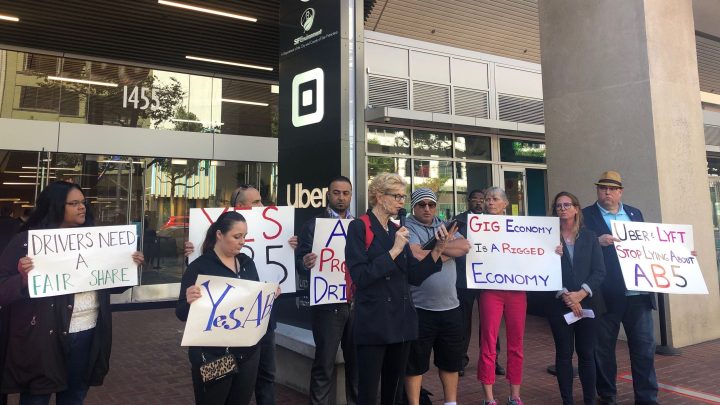
Lyft drivers question the bonus payment system for high-demand areas
Lyft drivers question the bonus payment system for high-demand areas

California may upend the way gig economy workers — like drivers for Lyft and Uber — are hired and paid. The state legislature has passed a labor bill that would force companies to pay gig workers as employees instead of contract workers. The measure still needs to be signed by the governor and may go to a ballot referendum as well as face court challenges. But while all this plays out, drivers are still trying to make a living under the current gig economy rules. Lyft recently changed its rules nationwide for doling out bonuses to its drivers in congested areas.
The change was introduced a year ago and fully rolled out across the country this summer. Lyft says it’s a more equitable way to give out bonuses for rides. But some drivers say it’s eating into their profits.
Around four years ago, Lyft started paying drivers a bonus to go to areas where there was a lot of demand for rides, but not enough cars, like North Oakland during rush hour. Under that system, drivers would get a fare multiplier, like 1.4 times what they would normally earn on that ride.
“For those hours, as difficult as they were, you would make a decent hourly rate,” said Lyft driver Lauren Swiger.
She has been driving part time for Lyft for the past five years. Swiger said under the old system she could make around $200 a week driving two hours during rush hour every day. That averages out to about $20 an hour.
Then, Lyft came up with a new payment system, called Personal Power Zones, for areas where there is high demand for drivers.
“Now I think I would be lucky to make a hundred dollars,” Swiger said.
Swiger is a part of a group called Gig Workers Rising, which said it works with more than 900 drivers in California and is opposed to the switch.
“We actually jokingly call them Personal Poverty Zones,” Swiger said.
The new system uses flat rate bonuses, say a $4 bonus regardless of the length of the ride. Under the old system, Swiger sometimes could make a $12 bonus on a $30 ride.
Now, Swiger said, “Sometimes it maxes out at $4. And then so $4 instead of $12 is obviously a ridiculous incentive.”
Uber uses a combination of flat rate bonuses like Personal Power Zones and percentages like the old Lyft system.
Lyft wouldn’t make anybody available for an on the record interview but the company maintains while bonuses are smaller, more drivers are getting them. Lyft said that Personal Power Zones were designed to be more predictable, stable, and equitable. And they designed it to be stable for riders too, in terms of pricing. Lyft pointed out the that fares have been stable.
That’s true for rider Jared Ledoux, a music composer who uses both Lyft and Uber in Oakland during rush hour.
“I haven’t noticed a big difference,” he said. He said he’s concerned about the ability of driver to make a living but that the new information is probably not going to deter him from using Uber or Lyft.
“I would use it more to get from BART back to my house so I probably would still use one of them because I don’t want to do the walk,” Ledoux said.
Lyft says, on average, driver earnings across the country have increased over the last two years, but it doesn’t release raw earnings data.
Tom White, an analyst who follows Lyft for the financial services company D.A. Davidson, said that the change “generally resulted in drivers seeing their payouts reduced.” Lyft takes a percentage of all fares. White said that the company has been taking about 8% more from those fares over the last two years.
“The main contributor to that increase is that drivers are earning less than they used to,” White said.
Lyft argues the addition of bike and scooter services accounts for the increase. It takes 100% of the fees on those since there’s no driver to pay.
But White said bikes and scooters are only a small share of Lyft’s overall business and not enough to account for that 8% increase. White said the change is part of Lyft’s effort to become profitable. The company lost more than $900 million last year.
“You know investors won’t be patient forever,” White said.
The company went public this year and White said Lyft is keen to demonstrate to shareholders it does have a plan to become profitable eventually. The question for drivers is whether working for Lyft is still profitable enough for them.
There’s a lot happening in the world. Through it all, Marketplace is here for you.
You rely on Marketplace to break down the world’s events and tell you how it affects you in a fact-based, approachable way. We rely on your financial support to keep making that possible.
Your donation today powers the independent journalism that you rely on. For just $5/month, you can help sustain Marketplace so we can keep reporting on the things that matter to you.












